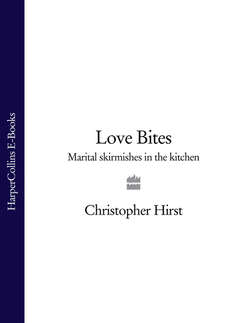Читать книгу Love Bites: Marital Skirmishes in the Kitchen - Christopher Hirst - Страница 7
SEEKING GLORY
ОглавлениеDESPITE HAVING SCORED some notable successes in the breakfast area, I began to experience a twinge of dissatisfaction. A boiled egg is fine in its way, but it does not generate the ovations and rave reviews that male cooks crave. It is not enough for our dishes to be nutritious, tasty and satisfying. They should also produce a storm of applause, amazement, even adulation. ‘Bravo! Bellissimo! Wunderbar!’ Extreme examples of this phenomenon are commonplace in the higher echelons of the gastronomic world. It always strikes me as curious that when, at the end of a banquet, the chef appears from the kitchen, he is greeted with a round of applause. Where else, outside the theatre, does anyone get such acclamation for doing his everyday job? Do we clap a road-layer when he completes a particularly fine bit of motorway? Or the refuse collector when he empties our bins with aplomb?
There was another less egocentric reason for expanding my culinary repertoire. Three years into our relationship, I went freelance and began working from home. Mrs H continued working on the other side of London. On her return journey, she would often call in Reggie Perrin-style, ‘Only just reached Victoria. Points failure at Acton. Have pipe and slippers waiting.’ It was obviously unfair to expect her to start bashing away in the kitchen when she staggered through the door at 8.30 p.m. My gallantry was given additional impetus by the hunger pangs I began to feel three hours earlier.
Starting with salads, I moved on to pasta, stews and casseroles (all remain gastronomic mainstays at Hirst HQ). Eventually, the day came when I graduated from hob to oven. Like a small, super-heated theatre in the corner of the room, its productions are more likely to elicit acclaim than something scooped from a saucepan. Mrs H was certainly impressed by my efforts. ‘I’d come home completely drenched to find the house full of delicious smells and you with a spoon in your mouth having a tasting session. Even though bits of mashing potato were often flying through the air, it was very welcome.’
Mrs H was referring to my slightly feverish construction of fish pie. ‘I remember that it always contained large quantities of cockles. A bit odd but rather delicious.’ She was also fond of my robust version of coq au vin: ‘Your great glug of brandy made it very sustaining. I had to go to bed immediately afterwards.’ Pheasant casserole in a Calvados and cream sauce was even more satisfying. ‘After a single bowl, I felt as if I might go pop!’
All good stuff that provided much in the way of the requisite congratulation, acclamation, etc. The response to my next production was more ambivalent. While not exactly a flop, it received a mixed review. ‘I remember coming home and there was this Desperate Dan-style thing on the kitchen table,’ Mrs H recalls. ‘It was a vast pie with a patchwork lid. You stood behind it covered in flour and exuding pride from every pore.’
Well, yes, maybe I did generate a hint of righteous self-satisfaction at my first substantial baking achievement. ‘It was certainly substantial,’ says Mrs H. ‘I don’t think I’ve ever seen a bigger pie. In some parts the pastry was very thick, in other parts it was so thin that it disappeared. Still, it tasted OK if you ignored the very doughy bits. My problem was with the inside. I don’t like sweet pies and I particularly don’t like them filled with rhubarb.’
This is a mystery to me. How can anyone not like rhubarb pie? ‘Quite easily,’ says Mrs H. ‘Rhubarb is quite nice tasting but it collapses into a pink, stringy mush in a pie.’
Her antipathy is supported by one of Britain’s greatest food writers. ‘Nanny food,’ Jane Grigson seethed in her Fruit Book. ‘Governess food. School-meal food.’ In case we haven’t got the message, she went on: ‘I haven’t got over disliking rhubarb, and disliking it still more for being often not so young and a little stringy…Only young pink rhubarb is worth eating.’
Though expounded by two of my favourite authorities, Mrs G and Mrs H, I strongly disagree with this view. We almost always used mature stalks in the most memorable dessert of my childhood. Though somewhat bulkier than Proust’s madeleine, a rhubarb pie has the same effect on me. Its combination of bittersweet, tooth-etching filling and juice-infused pastry instantly whisks me back to the West Riding of Yorkshire circa 1962. I grew up near the legendary Rhubarb Triangle between Leeds, Wakefield and Morley. Or is it Bradford? Opinions vary about the location of this locale, almost as mysterious as its Bermudan counterpart, but we certainly had several rhubarb plants in the garden of our house in Cleckheaton. In consequence, I ate a lot of rhubarb as a child – almost always in pie form, very occasionally stewed, never under the crunchy awning of a crumble.
If Mrs H was a non-starter in the Rhubarb Pie Appreciation League, I found a more willing recipient in the form of Mrs H’s mother. If she was surprised when her daughter’s live-in boyfriend started serving her rhubarb pie on a regular basis, she did not express it to me. Admittedly, my Proustian pud did not whisk her back to a Yorkshire childhood, but this was scarcely surprising since she came from Surbiton, Surrey.
